Thanks for your support! If you make a purchase using our links in this article, we may make a commission. And, as an Amazon Associate, I earn from qualifying purchases. See the full disclosure here.
Choosing the Right Materials to Replace Your RV Ceiling Panels
If you are an avid RVer, you understand the grand feeling of touring America in your very own RV. The freedom you have, the sights you see, and the friendly people you meet. An RV is a ticket to fun, freedom, and exploration. However, when that trusted old friend begins to show signs of age and is starting to look a bit “run down,” it may be time for a facelift.
There are many things you can do to renovate your RV. You can replace the dinette table, the vinyl flooring in the kitchen, the worn-out carpet, as well as that tired old sofa. Also, you can install new paneling, wallpaper accent walls, a computer desk. You can paint, reupholster the furniture, or change the curtains.
Many older RV’s can have damage from leaking around vents, AC units, or skylights. You can fix the leaks, but you are often then left with unsightly water damage to your RV’s interior ceiling panels. If you are really adventurous, you might even consider replacing your RV’s ceiling. While it might be a little more work than some other renovation tasks, a beautiful new ceiling can help go a long ways toward making your old RV shine like new.
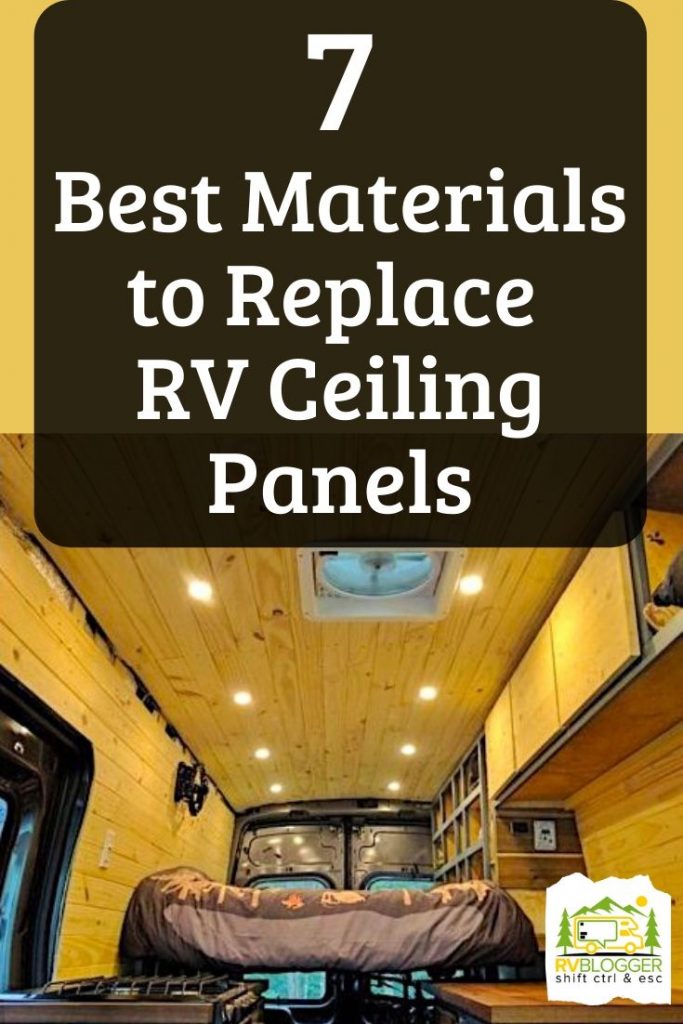
The best materials to replace your RV ceiling panels are:
- Wood
- Metal
- Fabric
- Vinyl/PVC
- Paneling
- Plastic
- Fiberglass
If you are considering replacing your RV’s 4 x 8 ceiling panels, the question then becomes, what is the best material with which to replace it? Let’s take a look at some of the materials available to replace and upgrade your RV’s ceiling and give it a great new look.
1. Using Wood for Your RV Ceiling
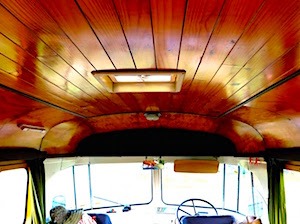
For many, plywood is a popular choice for many reasons. It is inexpensive, you can easily cut it to any size or shape, and you can stain it or paint it to get the look you want. Plywood is readily available at any building supply center, and you can paint it to match most any décor.
You need to remember that plywood and water do not do well together. Therefore, it would be wise to double check any leaks you may have previously had to be sure they no longer leak. It would be a real shame to put a lot of hard work into replacing your RV’s ceiling, only to have a stubborn leak ruin it for you. Also, remember that plywood is flammable, so be careful with your wiring and any fire hazards.
2. Metal RV Ceiling Panels
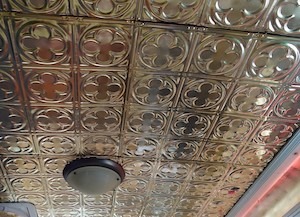
Like plywood, metal ceiling coverings can be finished or painted to suit your tastes. Because your new ceiling is made of metal, it will not rot, crack, or absorb moisture or odors. It can even add strength to the RV’s structure. And it’s very easy to clean.
Metal ceiling coverings hide imperfections, they are fire resistant and require minimal maintenance. Once your new ceiling is installed and finished, it will be easy to clean with a quick wipe from time to time.
3. Fabric RV Ceilings
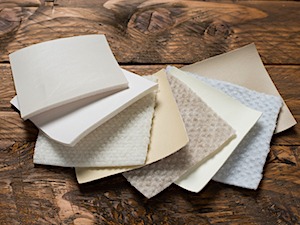
There are always newer and better fabric ceiling products available on the market. The range of fabrics for RV ceilings has improved over the last several years.
Like metal ceiling coverings, the fabric can cover ugly imperfections. Also, as with metal coverings, you will need to be sure there are no leaks or water damage you need to repair before installing the new fabric on the ceiling.
However, fabric ceiling covers do have several drawbacks. No matter how good your new fabric ceiling looks, keep in mind that fabric ceilings are extremely difficult to clean. They also are very good at absorbing both odors and moisture.
4. Vinyl/PVC RV Ceiling Material
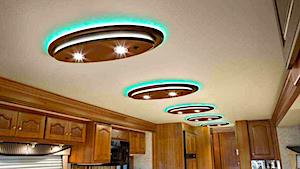
Vinyl RV Ceilings are very often found in higher end RVs since vinyl is a perfect material to create custom ceilings. The smooth leather-like texture provides an elegant and upscale look.
You want something that stands up well to all the wear and tear. In addition, vinyl or PC tiles are also waterproof, easy to clean and, very often, flame retardant.
5. You Could Use Paneling for Your RV Ceiling
Paneling is an option you might also consider. In most respects, it will be very similar to plywood as far as installation and how it performs. Paneling has the added benefit of coming in a variety of colors or patterns, and if needed, you can even paint it. Paneling will also have many of the same drawbacks of plywood. For instance, like plywood, paneling does not handle water well.
 6. Plastic and Styrofoam RV Ceilings
6. Plastic and Styrofoam RV Ceilings
Plastic or styrofoam ceiling tiles are another excellent option. These ceiling tiles are super light-weight and can be cut with a good pair of scissors. They are then glued in place using a good quality construction adhesive. Again, you need to make sure that the surface you are sticking them to is solid and clean.
Like many of the other ceiling covering options, plastic tiles can hide a multitude of sins. While not as durable as metal or vinyl or PVC tiles, they can hold up well and are easy to wipe clean.
7. Consider Fiberglass for Your RV Ceiling Material
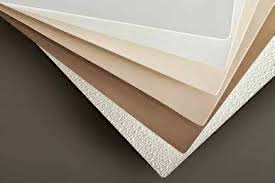
You may want to consider using brads around the perimeter edges as well as around vents or light fixtures. These will be hidden by the molding around the perimeter and by the bezels of any vents or light fixtures.
Fiberglass reinforced panels are quite durable, waterproof, easily cleaned. As with many of these options, it will be essential to ensure the surface you are gluing them to is in sound condition, meaning no leaks, water damage, or delamination.
Insulate Your RV Ceiling Before Adding New Ceiling Material
Okay, so clearly insulation isn’t actually a camper ceiling material. However, if you are going to replace the ceiling in your RV, this would be an ideal opportunity to add to or upgrade the insulation. Improving the insulation in your RV’s roof will keep more heat in when it’s cold, and will help keep the heat out when it’s hot. Improved insulation will save energy and keep your heating costs down. It’s almost a no-brainer.
Which Ceiling Material is the Best Choice?
To help you to make the right choice in ceiling material for your RV, here is a list of things you will want to keep in mind while considering your options.
Where Are You Using the RV Ceiling Material You are Considering?
While some materials are suitable for use anywhere, others may only be suitable for specific areas or under certain conditions. Consider all the practicalities before making your final selection. While you can use just about any ceiling cover in the bedroom, your choices for kitchen and bathroom might need a bit more thought. Another consideration would be whether or not you want the same ceiling throughout your RV. This choice may depend on your floor plan and decor.
Get a Little Help From Your Friends!
It a pretty good idea to tap into the experiences of friends and other RVers. It could be helpful to learn from their mistakes, rather than repeat them. You might even get a chance to see their successes as well. The can help you save you both time and money.
Does the RV Ceiling Material Need to be Waterproof?
If you’re replacing the bathroom or kitchen ceilings, you’re certainly going to want something that has a waterproof finish. Showers and cooking can release a lot of water vapor into your RV’s interior. Meal preparation adds the possibility of lingering odors. Waterproof finishes tend to be easy to clean and do not absorb odors.
How Hard is it to Clean the Ceiling Material?
Another thing to think about is whether or not you want to replace your badly stained camper ceiling with one that is also easily stained and equally difficult to clean! Ideally, you would select a ceiling material that is easily wiped clean with a cloth. It is easy enough to test how hard it is to clean a ceiling material you are considering. Take a sample and get it dirty using the kinds of things that might stain the ceiling in normal usage. Then try cleaning it.
How Long Will the Ceiling Material Last?
If you are going to invest valuable time, money, and effort into your ceiling renovation, make sure that you’re going to be able to get several years out of your new ceiling. Materials like metal and vinyl/PVC are going to last the longest and have several other desirable qualities, such as being waterproof, odor resistant, and even easy to install.
We can assume that, sooner or later, all skylights will develop a leak. Therefore, you need to consider your options thoroughly. While many consider fabric and plywood as durable options, they could have a much shorter lifespan than a waterproof metal, vinyl, or PVC ceiling.
Is the RV Ceiling Material Fire Resistant?
Safety should always be a consideration! Check the fire safety rating of any material you’re thinking of using in your RV. Even if your RV does not have any naked flames such as on a gas stove, it is essential to protect yourself and your possessions. You may want to check with your insurance provider when considering the renovations you are planning for your RV. It is a good idea to make sure that the changes you are planning do not somehow void your coverage.
Can You Do The Ceiling Installation Yourself?
So, you have just made your choice of the perfect RV ceiling material. The question now is, can you do the actual installation? Some installations will be easier than others. If your heart is set on one that is more difficult or beyond your skills, you may want to get some help. Hopefully, you will be looking at your new RV ceiling for a long period. You will want to make sure you have the ceiling you wanted, that it is installed properly, and that it looks great!
Conclusion
Renovating your RV can be a grand adventure itself, especially if you take the time to do a little research and planning beforehand. Check out all the possibilities, talk to the experts, make your decisions, and then jump in. You can have fun giving your RV its need facelift. Plus, there is the added enjoyment of bragging rights later when out on the road socializing with your fellow RVers.
Do you have a creative idea for an RV ceiling? Please share your idea in the comments below!
Below are some other helpful articles about RV interiors.
- RV Window Tinting
- DampRid vs Dehumidifier – How to Reduce Humidity in an RV
- Best Lightweight Dinette Table Top Replacement For Your RV or Camper

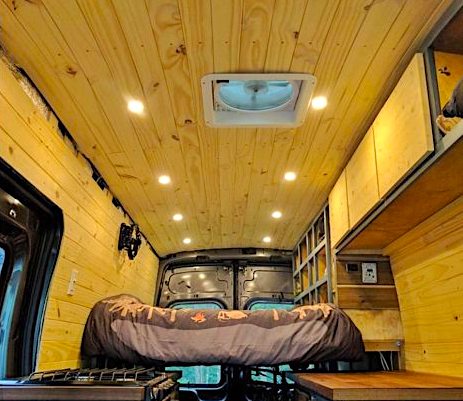
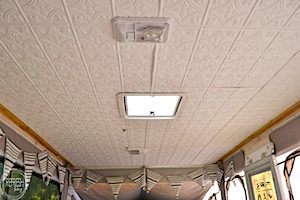 6. Plastic and Styrofoam RV Ceilings
6. Plastic and Styrofoam RV Ceilings
How do I find a PROFESSIONAL INSTALLER to install my New metal ceiling? I’m looking for a Professional and in 2022, finding hard working reliable knowledgeable technicians are like finding a needle in a Haystack. All talk, but failures in producing quality workmanship. If anyone knows someone please let me know thank you so very much. Padre
I used some ribbed soffit from vinyl siding to finish my sprinter ceiling. Light, cheap,easy to clean,
bendable, soft if you bump it. and looks sharp too!
That’s a great idea!
Thanks!
Mike
What did you use to glue it up?
Where did you buy the ribbed soffit siding? My RV has a crack in the ceiling in the bathroom but it doesn’t have a leak. I want it to look better with an easy remodel.
Cindy
To kill mold and mildew use amix of water and hydrogen peroxide. Use a sprayer to apply it. A friend was told this to get rid of mold in her attic, and it worked.
Please help….we have a very good chance to buy a nice motor home..but..the roof leaked above the living rm..around vent. The seller said its fixed? How can we be sure? And how do we replace the very stained ceiling. I thought of a contrast color?? The price is very low..but the repair may be higher? Can you offer ideas? I also worry about mold.
Hi there
Has anyone any input on liquid water sealer? We are thinking of stripping our 5th wheel down to the bones, liquid water sealing, insulating and then panels back up on the interior.
We are going to address the exterior too! But we are doing the inside At the moment.
Any recommendations or input would be appreciated.
Thanks in advance.
Need to do something with RV ceiling had leak and was fixed and stains everywhere we just purchased off family member . I want to pain the fabric but not sire it will hide all the stains I did use kill up right spray but will need more after one can didn’t hide. I was planning on using fabric paint or a paint that is suitable for ceiling. But I really like the styrofoam ceiling tiles. Has anyone placed them directly on the headliner without removing any ceiling fabric?
Hi Star,
Hopefully, someone who has tried what you are asking about will see your question. You could also ask this question on a forum like iRV2.com and see if anyone has any advice.
Best of luck,
Mike
I’d like to know this also.
I have a 1987 Chevy C30 class C. Due to leaky upper cab, I replace the wood frame with metal. What is the best solution to insure no more roof leaks? And what is the best way to insulate the inside ceiling. Also, while parked at RV park and plugged in to electric, should the battery shut off switch be, On or Off. Something is running my engine battery down. Thanks
Hi Kevin,
With the older style Class C RVs there is always the possibility of a leak since the overcab is attached as a separate piece and the joints are just caulked in place to create a seal. Those caulk joints will crack for sure over time. So, unless you get a fiberglass one-piece overcab you are at risk for a leak.
We are in the same boat as you because we have a class C too. And we had a leak in the overcab. I caulked everywhere and used Eterna Bond tape and Dicor Lap sealant everywhere – I thought. Finally, I realized that the leak was coming from the factory deal along the side of the overcab. Once I caulked that we have been leak-free. But that caulk will become brittle and crack at some point and it will leak again and I’ll have to strip it out and recaulk it all again. Ugh!
The best way to insulate the ceiling is with a hard foam product that is not susceptible to m old.
As far as the battery shutoff switch, I recommend you leave it in the on position even when you have shore power. That has nothing to do with why your engine battery is running down. Something else must be draining the engine battery.
Great questions and I hope I helped!
Mike
Make sure power to your radio is off, too. I can’t tell which is off/on. And I have a water dmg cab over too. I had someone try to seal around but still.. I think it is same problem Mike had..outside edge seals..i don’t know best kind of caulk or sealer..could someone advise me? I have a 28ft 89 Travelmaster. I want to REMODEL it badly.
Does anyone know of a site that could show me my inside of Travelmaster like mine, and pictures of AFTER remodel? I have no ideas at all nor do I know how, but I CAN. thank you..
Evelyn
i glued a sheet of rubber roofing to mine 10 yrs ago
no leaks yet
a little work but worth it lifting vents and reinstaling them
chow